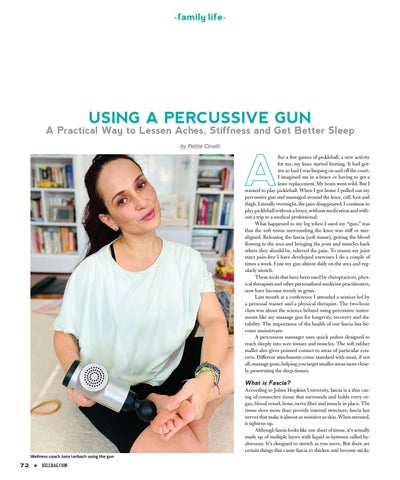. family life .
USING A PERCUSSIVE GUN
A Practical Way to Lessen Aches, Stiffness and Get Better Sleep by Pattie Cinelli
A
fter a few games of pickleball, a new activity for me, my knee started hurting. It had gotten so bad I was limping on and off the court. I imagined me in a brace or having to get a knee replacement. My brain went wild. But I wanted to play pickleball. When I got home I pulled out my percussive gun and massaged around the knee, calf, foot and thigh. Literally overnight, the pain disappeared. I continue to play pickleball without a brace, without medication and without a trip to a medical professional. What happened to my leg when I used my “gun,” was that the soft tissue surrounding the knee was stiff or misaligned. Releasing the fascia (soft tissue), getting the blood flowing to the area and bringing the joint and muscles back where they should be, relieved the pain. To ensure my joint stays pain-free I have developed exercises I do a couple of times a week. I use my gun almost daily on the area and regularly stretch. These tools that have been used by chiropractors, physical therapists and other personalized medicine practitioners, now have become trendy in gyms. Last month at a conference I attended a session led by a personal trainer and a physical therapist. The two-hour class was about the science behind using percussive instruments like my massage gun for longevity, recovery and durability. The importance of the health of our fascia has become mainstream. A percussion massager uses quick pulses designed to reach deeply into sore tissues and muscles. The soft rubber mallet also gives pointed contact to areas of particular concern. Different attachments come standard with most, if not all, massage guns, helping you target smaller areas more closely, penetrating the deep tissues.
What is Fascia? According to Johns Hopkins University, fascia is a thin casing of connective tissue that surrounds and holds every organ, blood vessel, bone, nerve fiber and muscle in place. The tissue does more than provide internal structure; fascia has nerves that make it almost as sensitive as skin. When stressed, it tightens up. Although fascia looks like one sheet of tissue, it’s actually made up of multiple layers with liquid in between called hyaluronan. It’s designed to stretch as you move. But there are certain things that cause fascia to thicken and become sticky. Wellness coach Jana Lerbach using the gun
72 H HILLRAG.COM










